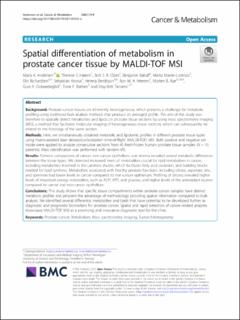| dc.description.abstract | Background
Prostate cancer tissues are inherently heterogeneous, which presents a challenge for metabolic profiling using traditional bulk analysis methods that produce an averaged profile. The aim of this study was therefore to spatially detect metabolites and lipids on prostate tissue sections by using mass spectrometry imaging (MSI), a method that facilitates molecular imaging of heterogeneous tissue sections, which can subsequently be related to the histology of the same section.
Methods
Here, we simultaneously obtained metabolic and lipidomic profiles in different prostate tissue types using matrix-assisted laser desorption/ionization time-of-flight (MALDI-TOF) MSI. Both positive and negative ion mode were applied to analyze consecutive sections from 45 fresh-frozen human prostate tissue samples (N = 15 patients). Mass identification was performed with tandem MS.
Results
Pairwise comparisons of cancer, non-cancer epithelium, and stroma revealed several metabolic differences between the tissue types. We detected increased levels of metabolites crucial for lipid metabolism in cancer, including metabolites involved in the carnitine shuttle, which facilitates fatty acid oxidation, and building blocks needed for lipid synthesis. Metabolites associated with healthy prostate functions, including citrate, aspartate, zinc, and spermine had lower levels in cancer compared to non-cancer epithelium. Profiling of stroma revealed higher levels of important energy metabolites, such as ADP, ATP, and glucose, and higher levels of the antioxidant taurine compared to cancer and non-cancer epithelium.
Conclusions
This study shows that specific tissue compartments within prostate cancer samples have distinct metabolic profiles and pinpoint the advantage of methodology providing spatial information compared to bulk analysis. We identified several differential metabolites and lipids that have potential to be developed further as diagnostic and prognostic biomarkers for prostate cancer. Spatial and rapid detection of cancer-related analytes showcases MALDI-TOF MSI as a promising and innovative diagnostic tool for the clinic. | en_US |

